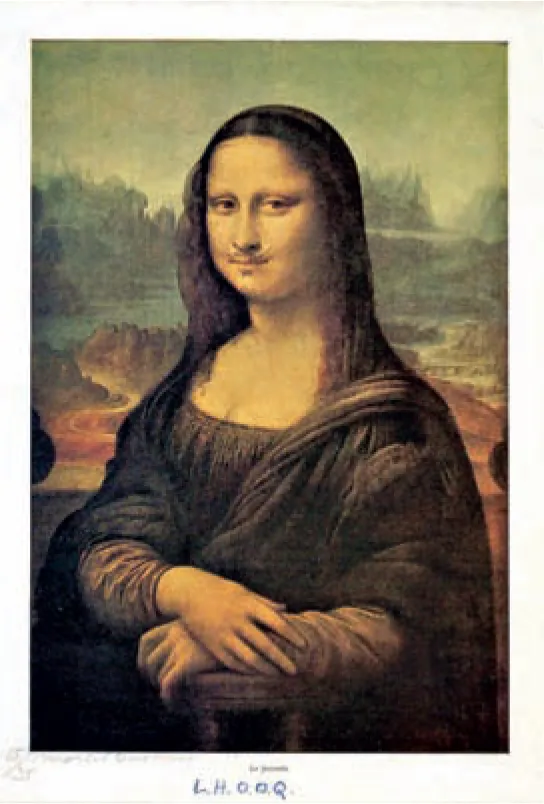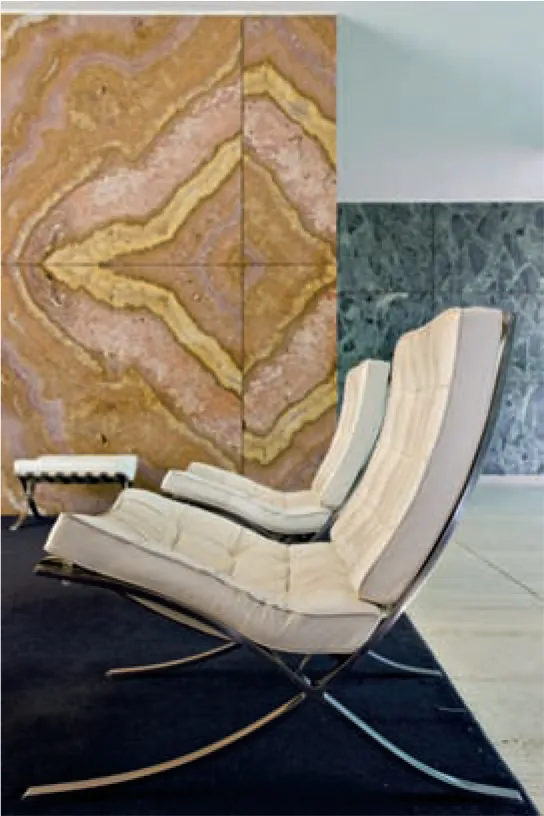![]()
1
Chapter 1 – Context
As both student and practising designer, it is important to develop and maintain an awareness of history and context in graphic design. Looking back across historical design eras, one can develop a reference bank of approaches and theoretical ‘tools’ for tackling design problems.
This section will look at some of the debates that have faced designers throughout history, as well as those that we face today. How do graphic designers see themselves within wider society? Is it a designer’s responsibility to be socially aware? This chapter does not propose answers to such questions. What is important, though, is that as a student or a practitioner of design, you are aware of these issues.
Contemporary practice
Postcard for an exhibition at the Bauhaus,1923
Wassily Kandinsky
The Bauhaus is best known as the most progressive art and design institution of the twentieth century. Its major aim was to encourage craftsmen and artists to collaborate, therefore evolving a new level of inter-relationships between art, design, craft and industry.
It is often said that nothing in design is new anymore. Designers continue to plunder the design vaults of the past, searching for inspiration and validation of their design approaches. However, what they often end up with is a rehash or pastiche of something that was really only fit for its original time and purpose.
The Bauhaus movement and the modernist style that followed it spawned a design revolution considered by many to be at the very heart of contemporary graphic design.
What Walter Gropius and his colleagues started at the Bauhaus was not about style; it was about functionality and form and was really an ideology. Admittedly, some aspects of Bauhaus design are based on aesthetics, but they also contain a rationale and reasoning. As the philosopher Immanuel Kant wrote, ‘thoughts without content are empty, intuitions without concepts are blind’.
Design for the sake of design is empty; it needs the backing of an idea with focus, and a sense of purpose for it to be truly successful. In our world of open-source technology – wikis, blogs and social networks – opportunities to create work with shallowness, based on laziness, assumption and presumption are numerous. The need for validation and reason is more important than ever before.
Styles, trends and fads will always come and go; they are driven by technology and the zeitgeist. But many do turn into established forms and approaches within the world of design, and therefore become marked periods within graphic design history.
As new technology and equipment has made designers more self-sufficient, the ability to transcend cultural and global boundaries has also increased. Designers can now draw influence from a limitless number of sources in order to respond to assignments and to produce creative work that will fulfil a client’s needs and requirements.
Much work currently seen as ‘contemporary practice’ can be described as digital design. Over the years, this will become an observation of this time and of the era in which it sits.
Zeitgeist
the spirit of the time; general trend of thought or feeling characteristic of a particular period of time.
History
Context and history have a bearing on all design work. The origins of graphic design are deeply rooted in art, craft and architectural practice. The first recognised evidence of visual communication comes in the form of the pictographs and symbols found in the Lascaux caves in southern France (15,000–10,000 BC). From the Arts and Crafts movement, Dadaism and the Bauhaus to postmodernism, we can draw influence to inform our own design practice. Research and inquiry can, in turn, create new approaches and outcomes. The following selection provides an introduction to some of the key movements that have both shaped and affected what we understand to be graphic design today.
L.H.O.O.Q.
Marcel Duchamp
Much of Marcel Duchamp’s work was typical of Dadaism. L.H.O.O.Q. was a postcard-sized reproduction of the Mona Lisa, on which he drew a moustache and goatee beard. It was an attempt to mediate between high and low culture, through the defacing of a cherished national institution.
Expressionism
Expressionism (1905–1925) originated in Germany. Inspired by symbolism, fauvism and cubism, it moved beyond the objectivity of its subjects to focus on the emotions and feelings of the artist.
Dada
Dada (1916–1922) was started in Zurich, Switzerland. An anti-art movement, its formation came as a direct criticism of and response to the atrocities of the First World War. Dada means literally ‘hobby horse’ and ‘father’, but the term was also chosen due to its childish phonetics. Much of the work of this period was nonsensical and used found objects.
Constructivism
The Russian constructivist movement focused on geometric principles and basic shapes such as squares, circles and triangles (a theme later revisited by the Bauhaus). Some of its roots stem from cubism, futurism and Russian suprematism. One of its main aims was to depict mechanisation and the growing power of the machine over the natural world.
Triangle, square, circle
The use of geometric principles and basic shapes in Russian constructivism was a theme later revisited by the Bauhaus.
Modernism
Modernism was formed around Western society’s new and developing industrialisation, and focused on the experimentation of form, process and technique. The new economic, social and political conditions that emerged from modernism affected the worlds of art, architecture, literature, religious faith, social organisation and even daily life. It literally took people out of the fields and placed them in factories, in turn forging a new industrialised society.
Following the Second World War, modernism became associated with the émigrés who fled Germany for America and other European countries. Mies van der Rohe, for example, was a key figure at the Bauhaus until pressure from the Nazi regime forced him to leave Germany to live and work in the USA.
Modernist design principles had a major effect on typography, and on its application and usage, in terms of grids and layout, leading, alignment, spacing and proportion.
Jan Tschichold, a German typographer, book designer, teacher and writer, embodied the modernist design principles he saw during his visit to the first Weimar Bauhaus exhibition in 1923. He became a leading advocate of the modernist ethic and with his book Die neue typographie, created a manifesto for modern design.
Initially condemning the use of all serif fonts, he eventually rejected this doctrine as being too extreme and reverted back to the use of classical Roman typefaces. In chapter 4, we will further explore the basis and historical background of typography – along with shape, balance and hierarchy – all of which form the basics for good design.
German Pavilion at the International Exposition in Barcelona, Spain
Mies van der Rohe
A reconstruction of the building in which Mies van der Rohe first used the grid as an ordering factor. It was designed to be a perfect example of modernism in architecture.
The...




